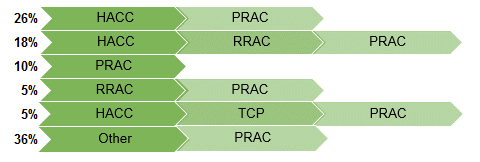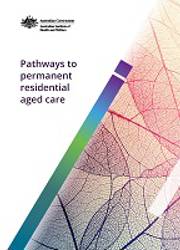Summary
In 2013–14, 61,300 people across Australia entered permanent residential aged care for the first time. This report presents analysis of their pathways through a range of aged care services, with a particular focus on the program last used before this transition. In all, the cohort had over 1,000 different pathways through the aged care system before entering permanent residential aged care (PRAC), using 1 or more of the following programs:
- Home and Community Care (HACC)
- Aged care packages
- Transition Care Program (TCP)
- respite residential aged care (RRAC).
HACC was the most common point of entry to the aged care system
The 5 most common pathways accounted for almost two-thirds of people:

Regardless of subsequent aged care program use, 76% of this cohort had first used HACC, and many of the pathways showed that people moved through aged care programs towards progressively higher levels of support.
Respite was most likely to be the last-used aged care program prior to PRAC
RRAC (39%) and HACC (36%) were the most common programs used last before entering PRAC. This was followed by TCP (8.2%) and aged care packages (7.0%). One in 10 (10%) people had not used other aged care programs before.
Last-used aged care program varied according to people’s demographic characteristics and health and functional status
Compared with other common pathways, people who had used no other aged care programs before their first entry to permanent care were more likely to be male (51%, compared with
36%–37% of those who had used another aged care program before entering permanent aged care); to be aged under 65; to have limitations in all 4 core areas (Self-care, Moving, Movement and Communication); and less likely to have lived alone. Compared to other programs, people who had last used TCP were more likely to have lived alone, to have been diagnosed with heart or cerebrovascular disease or to have experienced frequent falls.
Preliminary material: Acknowledgments; Abbreviations; Symbols
1 Introduction
- Pathways in Aged Care link map
- People in the cohort for this report
2 Pathways before first entry
- Broad patterns in the use of other aged care programs
- Most recent ACAT assessment
- Last use of other aged care programs
3 Further analysis options
Appendixes
Appendix A: Data tables
Appendix B: Methodology
End matter: References; List of tables; List of figures; Related publications



